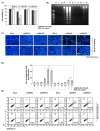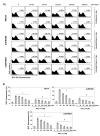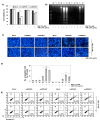Apoptotic Effects of Anthocyanins from Vitis coignetiae Pulliat Are Enhanced by Augmented Enhancer of the Rudimentary Homolog (ERH) in Human Gastric Carcinoma MKN28 Cells
- PMID: 33809701
- PMCID: PMC8002340
- DOI: 10.3390/ijms22063030
Apoptotic Effects of Anthocyanins from Vitis coignetiae Pulliat Are Enhanced by Augmented Enhancer of the Rudimentary Homolog (ERH) in Human Gastric Carcinoma MKN28 Cells
Abstract
Evidence suggests that augmented expression of a certain gene can influence the efficacy of targeted and conventional chemotherapies. Here, we tested whether the high expression of enhancer of the rudimentary homolog (ERH), which serves as a prognostic factor in some cancers, can influence the efficacy of anthocyanins isolated from fruits of Vitis coignetiae Pulliat, Meoru in Korea (AIMs) on human gastric cancer cells. The anticancer efficacy of AIMs was augmented in ERH-transfected MKN28 cells (E-MKN28 cells). Molecularly, ERH augmented AIM-induced caspase-dependent apoptosis by activating caspase-3 and -9. The ERH-augmented apoptotic effect was related to mitochondrial depolarization and inhibition of antiapoptotic proteins, XIAP, and Bcl-2. In addition, reactive oxygen species (ROS) generation was augmented in AIMs-treated E-MKN28 cells compared to AIMs-treated naïve MKN28 cells. In conclusion, ERH augmented AIM-induced caspase-dependent mitochondrial-related apoptosis in MKN28 cells. A decrease in expression of Bcl-2 and subsequent excessive ROS generation would be the mechanism for ERH-augmented mitochondrial-related apoptosis in AIMs-treated MKN28 cells. A decrease in expression of XIAP would be another mechanism for ERH-augmented caspase-dependent apoptosis in AIMs-treated MKN28 cells.
Keywords: MKN28 human gastric carcinoma cells; Vitis coignetiae Pulliat; anthocyanins; anticancer effects; apoptosis; enhancer of the rudimentary homolog.
Conflict of interest statement
The authors declare no conflict of interest.
Figures








Similar articles
-
Induction of apoptosis and inhibition of invasion in human hepatoma cells by anthocyanins from meoru.Ann N Y Acad Sci. 2009 Aug;1171:137-48. doi: 10.1111/j.1749-6632.2009.04689.x. Ann N Y Acad Sci. 2009. PMID: 19723048
-
Pretreatment of Anthocyanin from the Fruit of Vitis coignetiae Pulliat Acts as a Potent Inhibitor of TNF-α Effect by Inhibiting NF-κB-Regulated Genes in Human Breast Cancer Cells.Molecules. 2020 May 21;25(10):2396. doi: 10.3390/molecules25102396. Molecules. 2020. PMID: 32455624 Free PMC article.
-
Anthocyanins Isolated from Vitis coignetiae Pulliat Enhances Cisplatin Sensitivity in MCF-7 Human Breast Cancer Cells through Inhibition of Akt and NF-κB Activation.Molecules. 2020 Aug 9;25(16):3623. doi: 10.3390/molecules25163623. Molecules. 2020. PMID: 32784919 Free PMC article.
-
Anthocyanins From the Fruit of Vitis coignetiae Pulliat Potentiate the Cisplatin Activity by Inhibiting PI3K/Akt Signaling Pathways in Human Gastric Cancer Cells.J Cancer Prev. 2015 Mar;20(1):50-6. doi: 10.15430/JCP.2015.20.1.50. J Cancer Prev. 2015. PMID: 25853103 Free PMC article.
-
Induction of apoptosis in human leukemia U937 cells by anthocyanins through down-regulation of Bcl-2 and activation of caspases.Int J Oncol. 2009 Apr;34(4):1077-83. doi: 10.3892/ijo_00000234. Int J Oncol. 2009. PMID: 19287965
Cited by
-
Anthocyanins: From Natural Colorants to Potent Anticancer Agents.Food Sci Nutr. 2025 May 2;13(5):e70232. doi: 10.1002/fsn3.70232. eCollection 2025 May. Food Sci Nutr. 2025. PMID: 40321606 Free PMC article. Review.
-
The Endophytic Microbiome of Wild Grapevines Vitis amurensis Rupr. and Vitis coignetiae Pulliat Growing in the Russian Far East.Plants (Basel). 2023 Aug 15;12(16):2952. doi: 10.3390/plants12162952. Plants (Basel). 2023. PMID: 37631163 Free PMC article.
-
Anthocyanins Inhibits Oxidative Injury in Human Retinal Pigment Epithelial ARPE-19 Cells via Activating Heme Oxygenase-1.J Microbiol Biotechnol. 2024 Mar 28;34(3):596-605. doi: 10.4014/jmb.2310.10011. Epub 2023 Nov 13. J Microbiol Biotechnol. 2024. PMID: 38044685 Free PMC article.
-
Anticancer applications of phytochemicals in gastric cancer: Effects and molecular mechanism.Front Pharmacol. 2023 Jan 12;13:1078090. doi: 10.3389/fphar.2022.1078090. eCollection 2022. Front Pharmacol. 2023. PMID: 36712679 Free PMC article. Review.
-
Upregulated enhancer of rudimentary homolog promotes epithelial‑mesenchymal transition and cancer cell migration in lung adenocarcinoma.Mol Med Rep. 2024 Jan;29(1):9. doi: 10.3892/mmr.2023.13132. Epub 2023 Nov 24. Mol Med Rep. 2024. PMID: 37997813 Free PMC article.
References
-
- Sasako M., Sakuramoto S., Katai H., Kinoshita T., Furukawa H., Yamaguchi T., Nashimoto A., Fujii M., Nakajima T., Ohashi Y. Five-year outcomes of a randomized phase III trial comparing adjuvant chemotherapy with S-1 versus surgery alone in stage II or III gastric cancer. J. Clin. Oncol. 2011;29:4387–4393. doi: 10.1200/JCO.2011.36.5908. - DOI - PubMed
-
- Noh S.H., Park S.R., Yang H.K., Chung H.C., Chung I.J., Kim S.W., Kim H.H., Choi J.H., Kim H.K., Yu W., et al. Adjuvant capecitabine plus oxaliplatin for gastric cancer after D2 gastrectomy (CLASSIC): 5-year follow-up of an open-label, randomised phase 3 trial. Lancet Oncol. 2014;15:1389–1396. doi: 10.1016/S1470-2045(14)70473-5. - DOI - PubMed
MeSH terms
Substances
Grants and funding
LinkOut - more resources
Full Text Sources
Other Literature Sources
Medical
Research Materials

